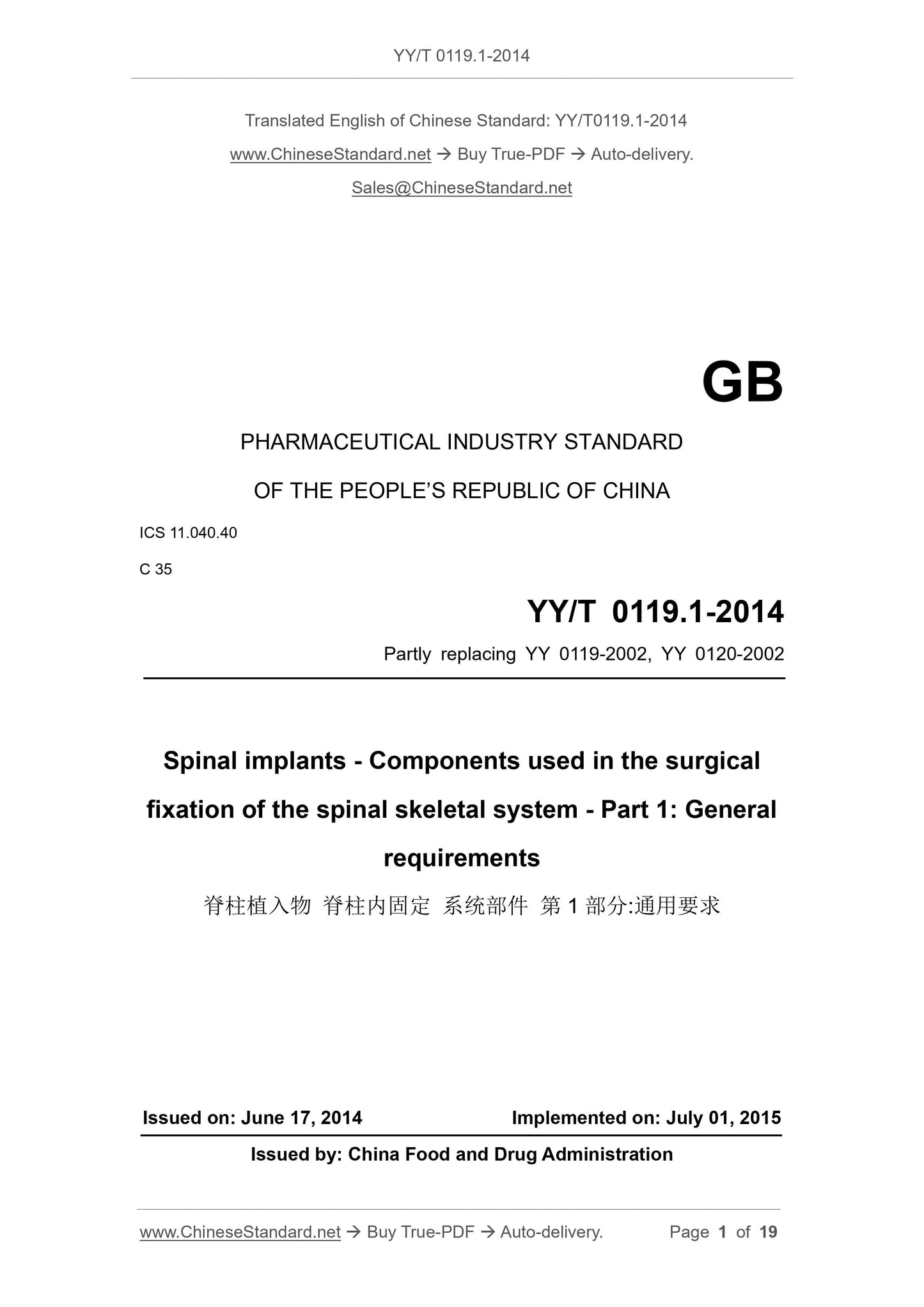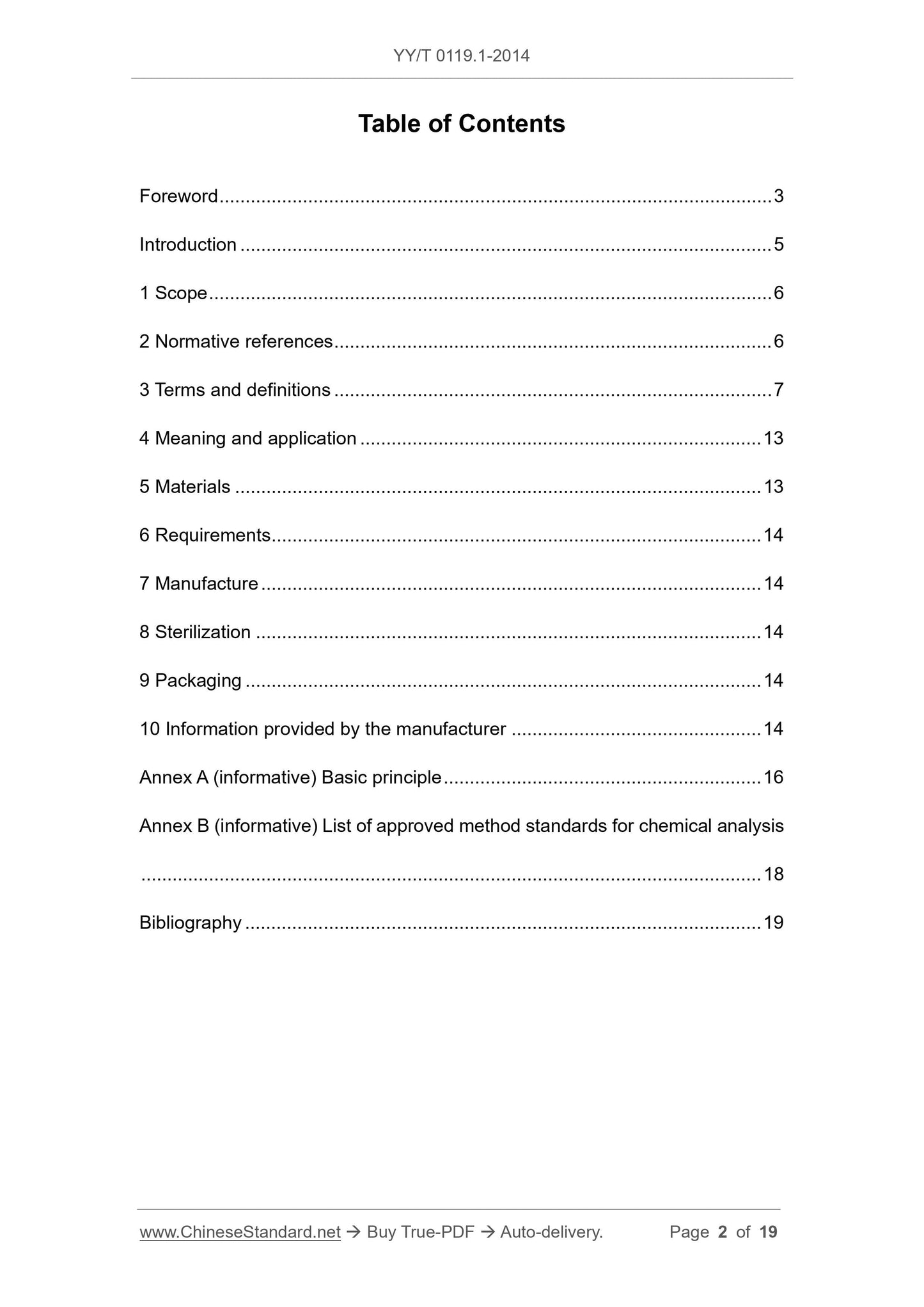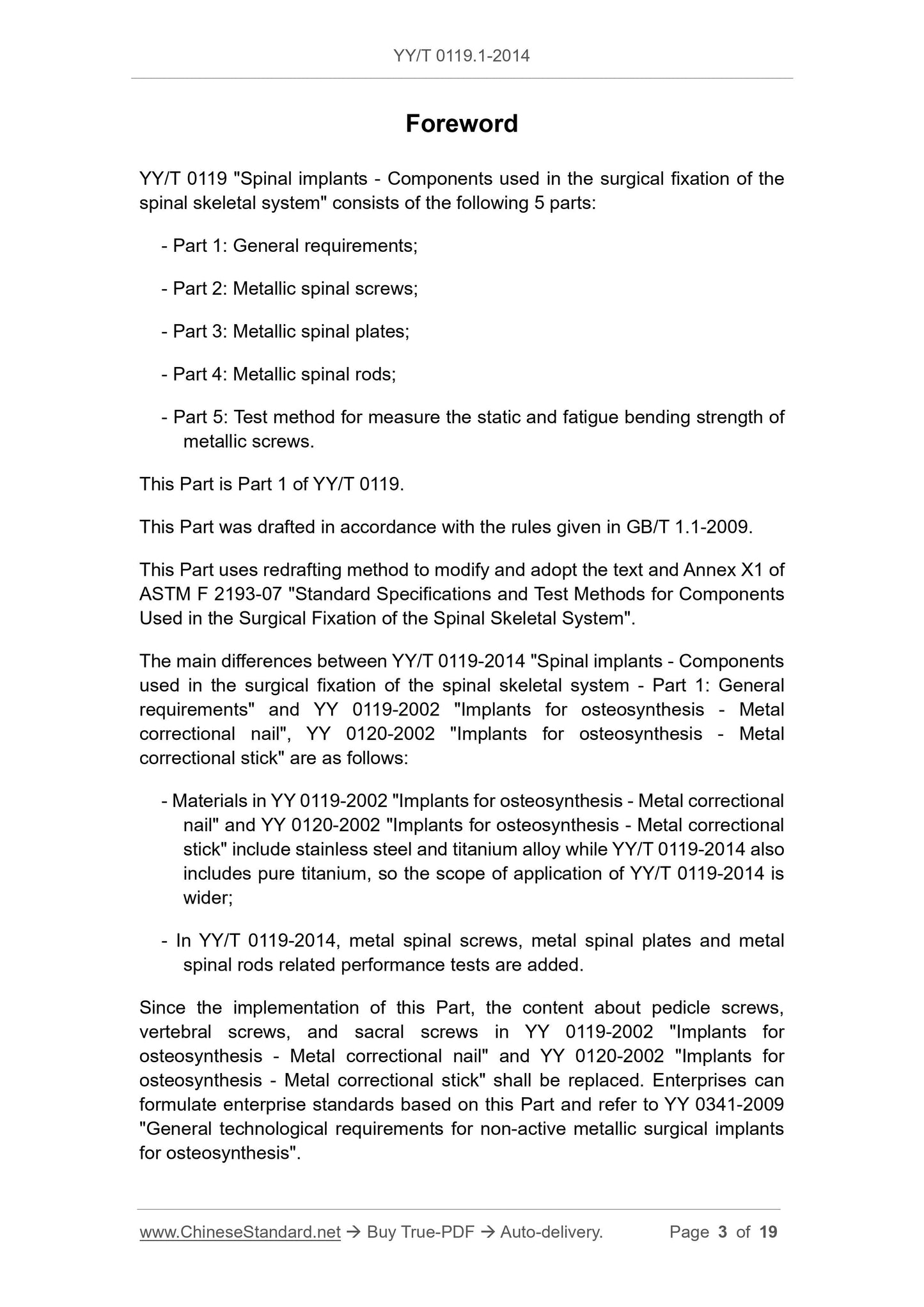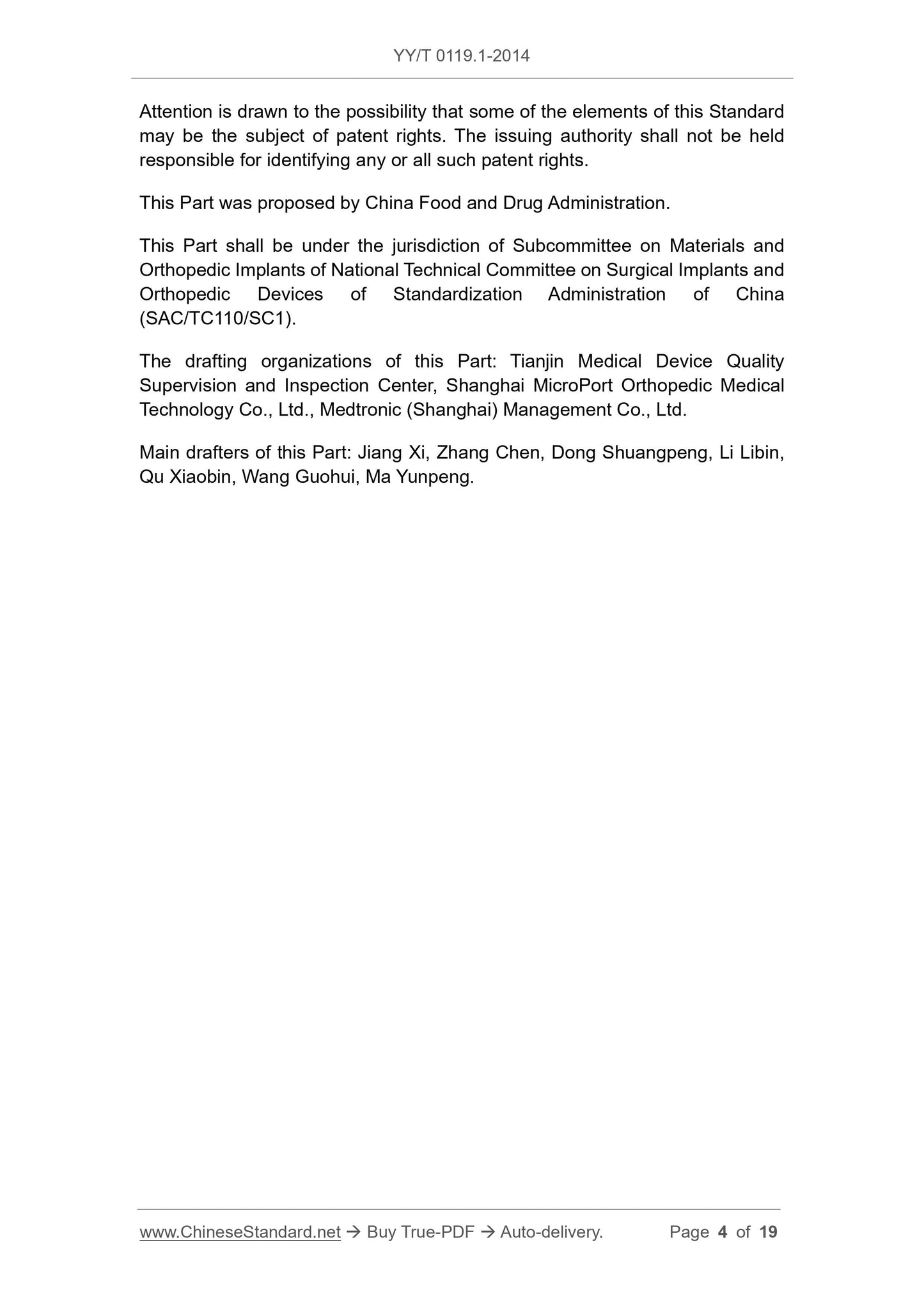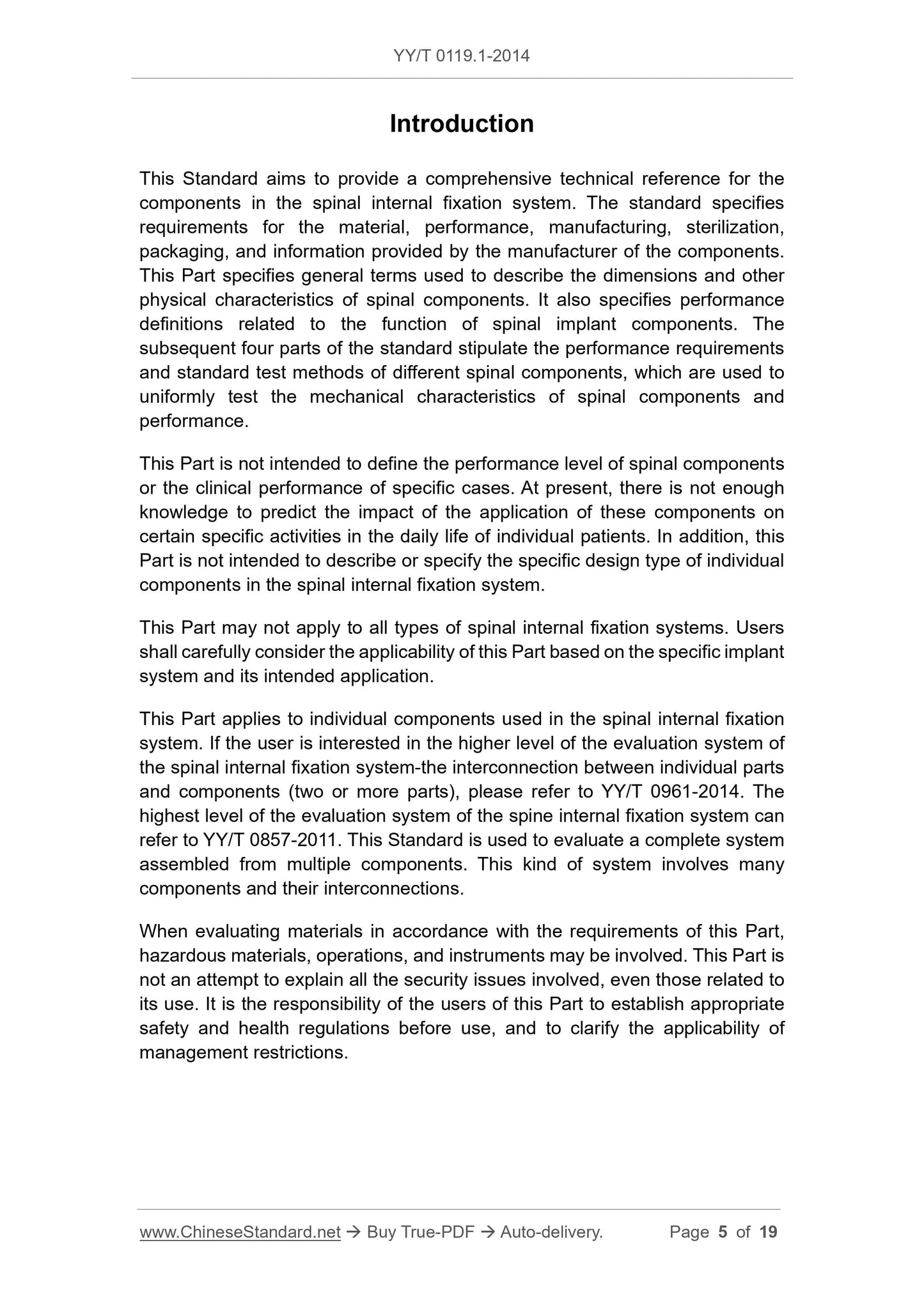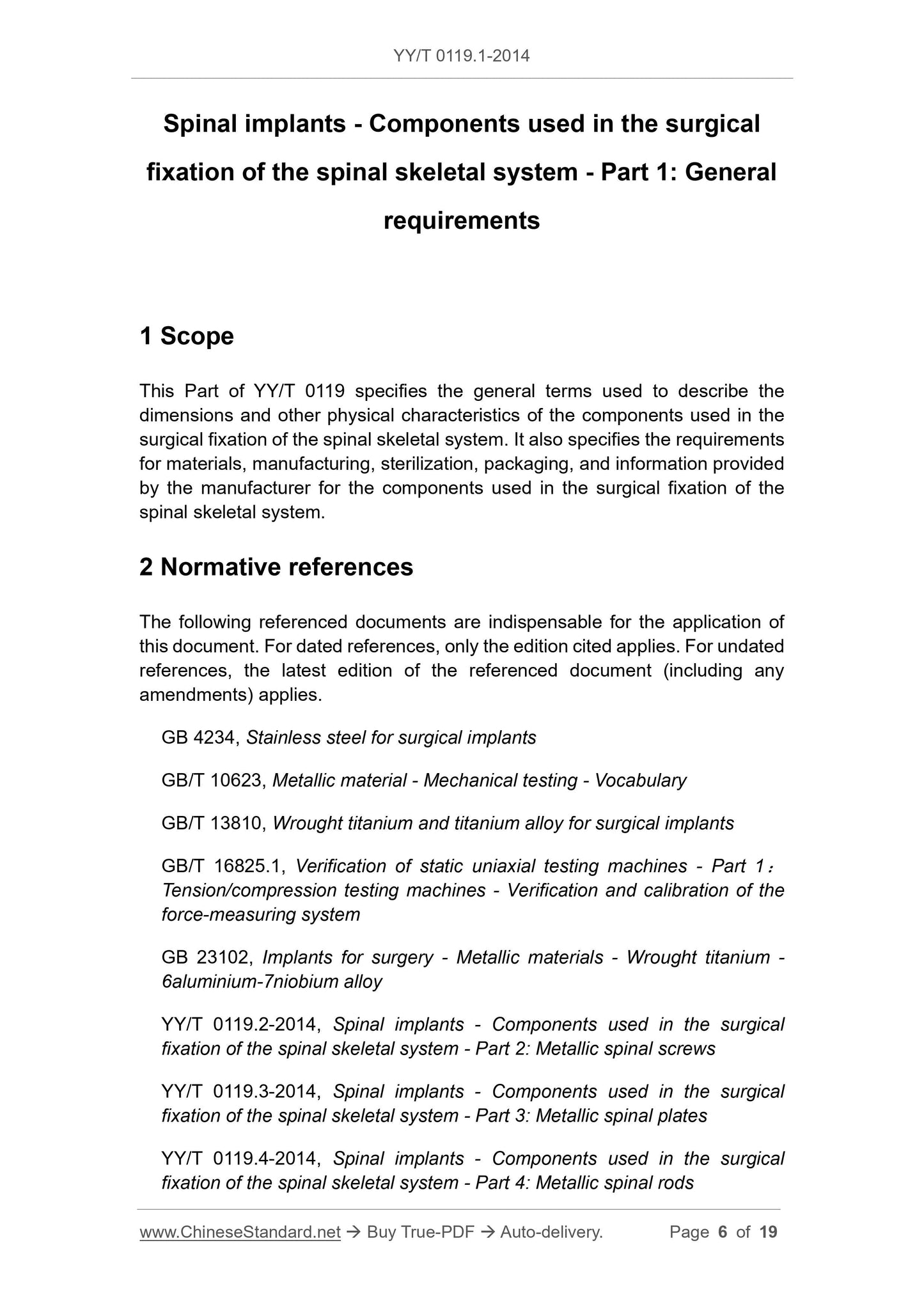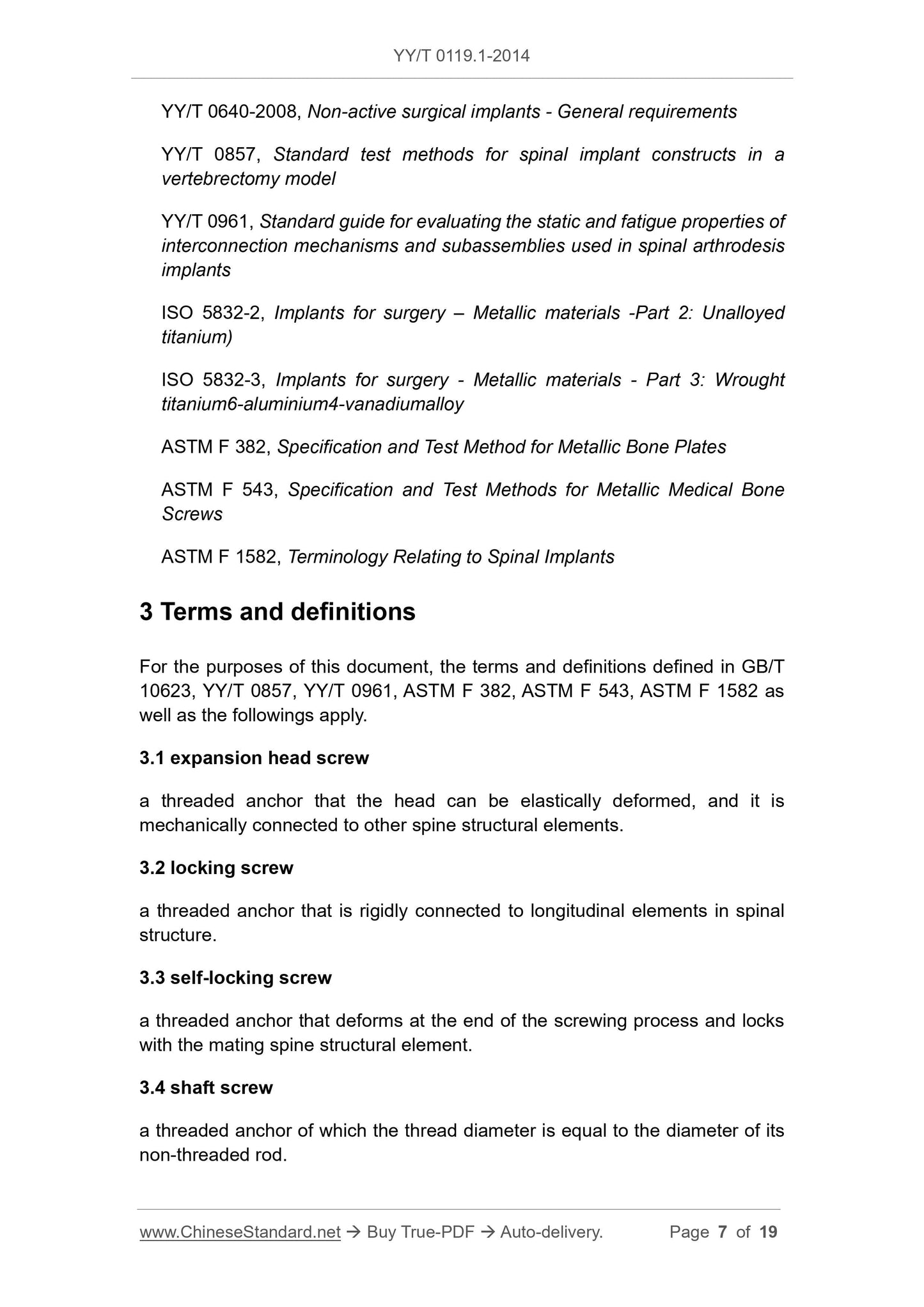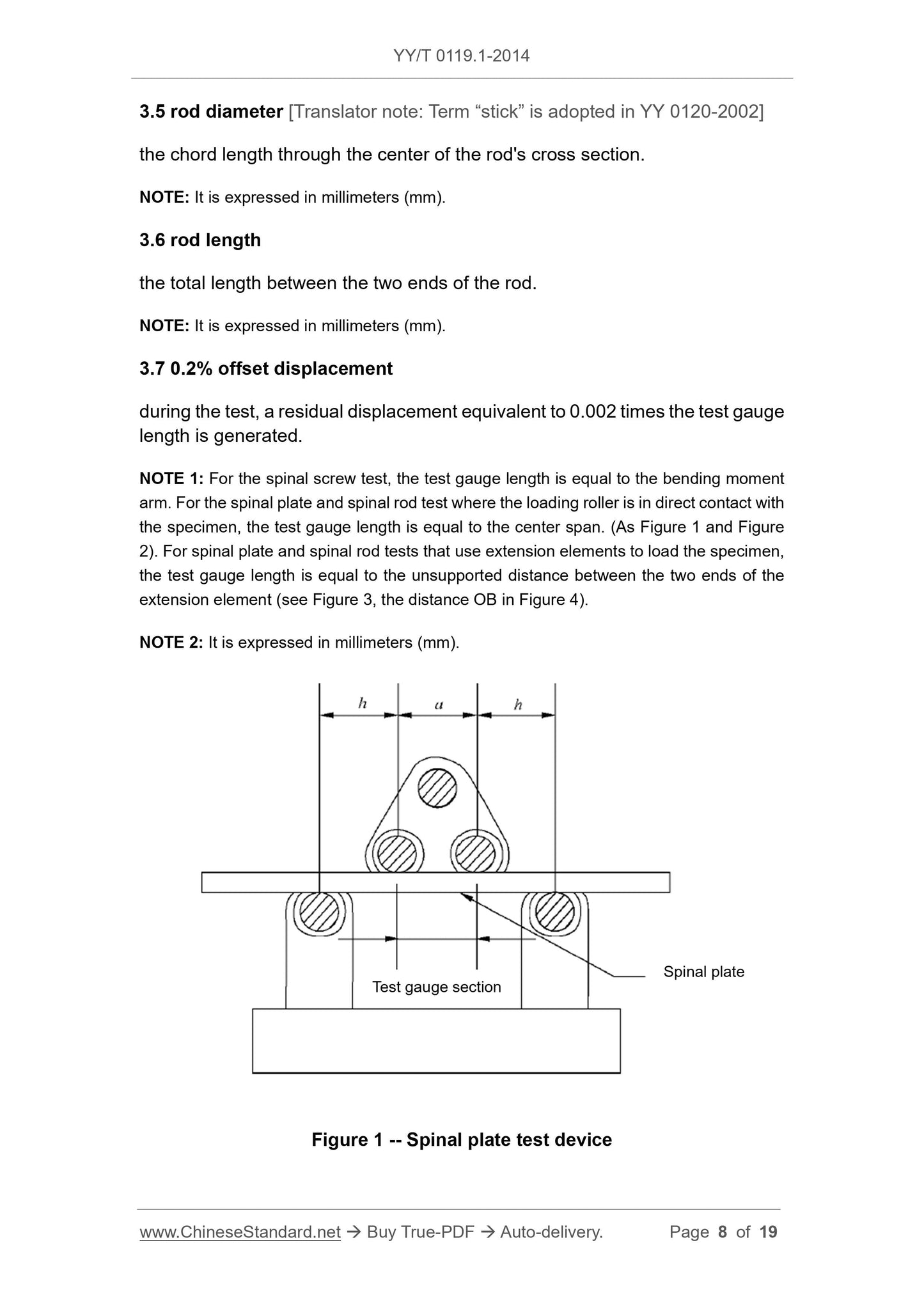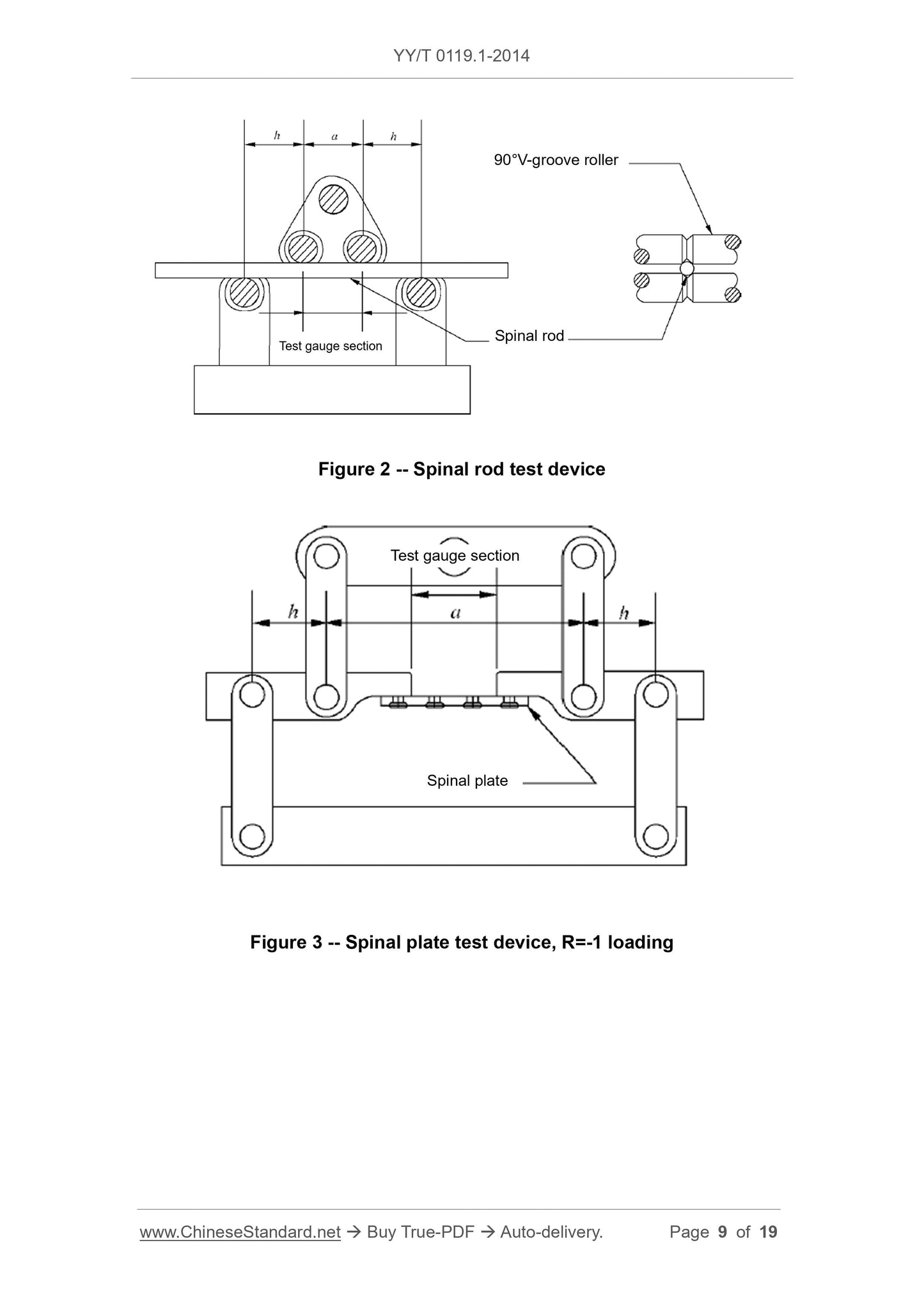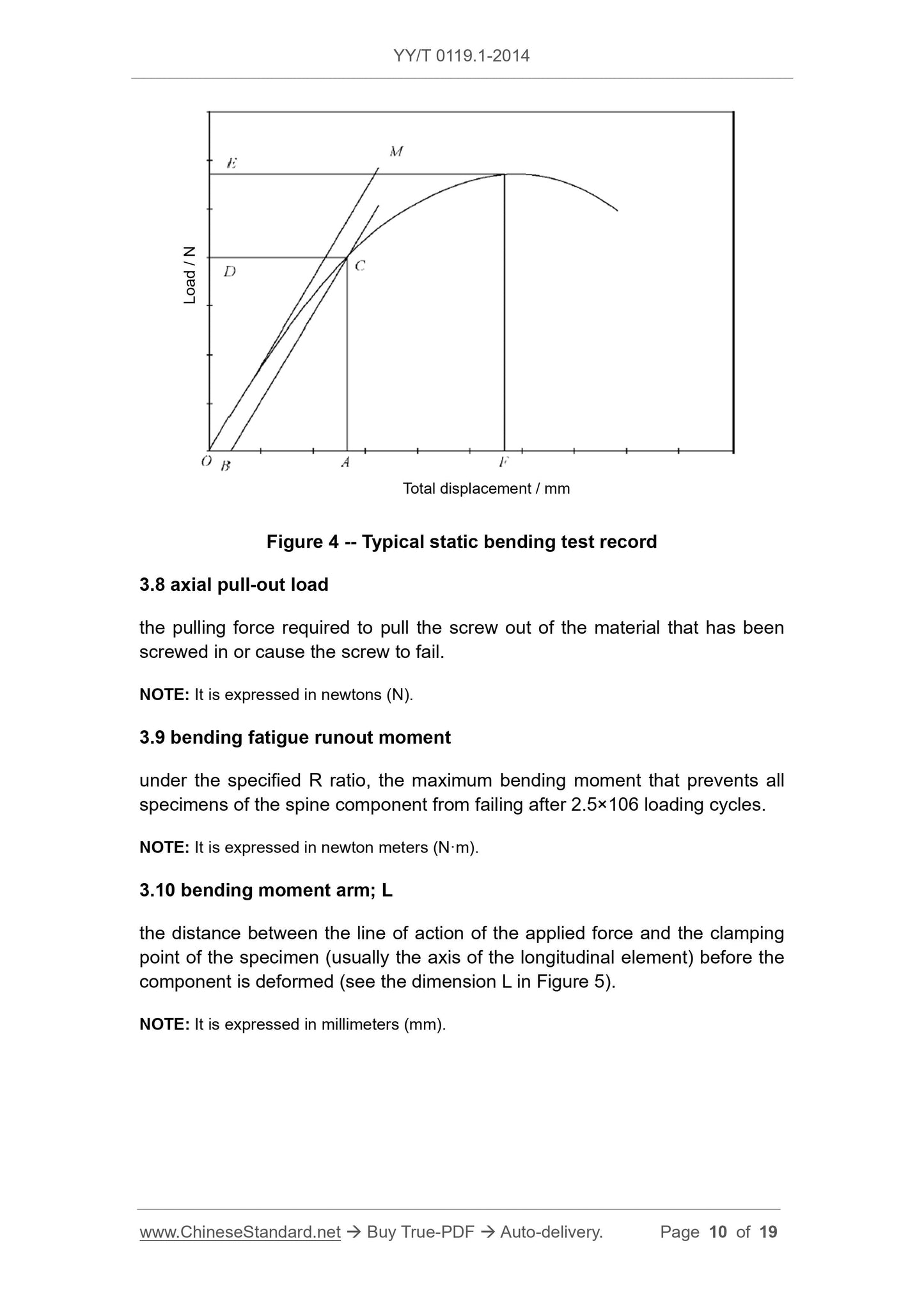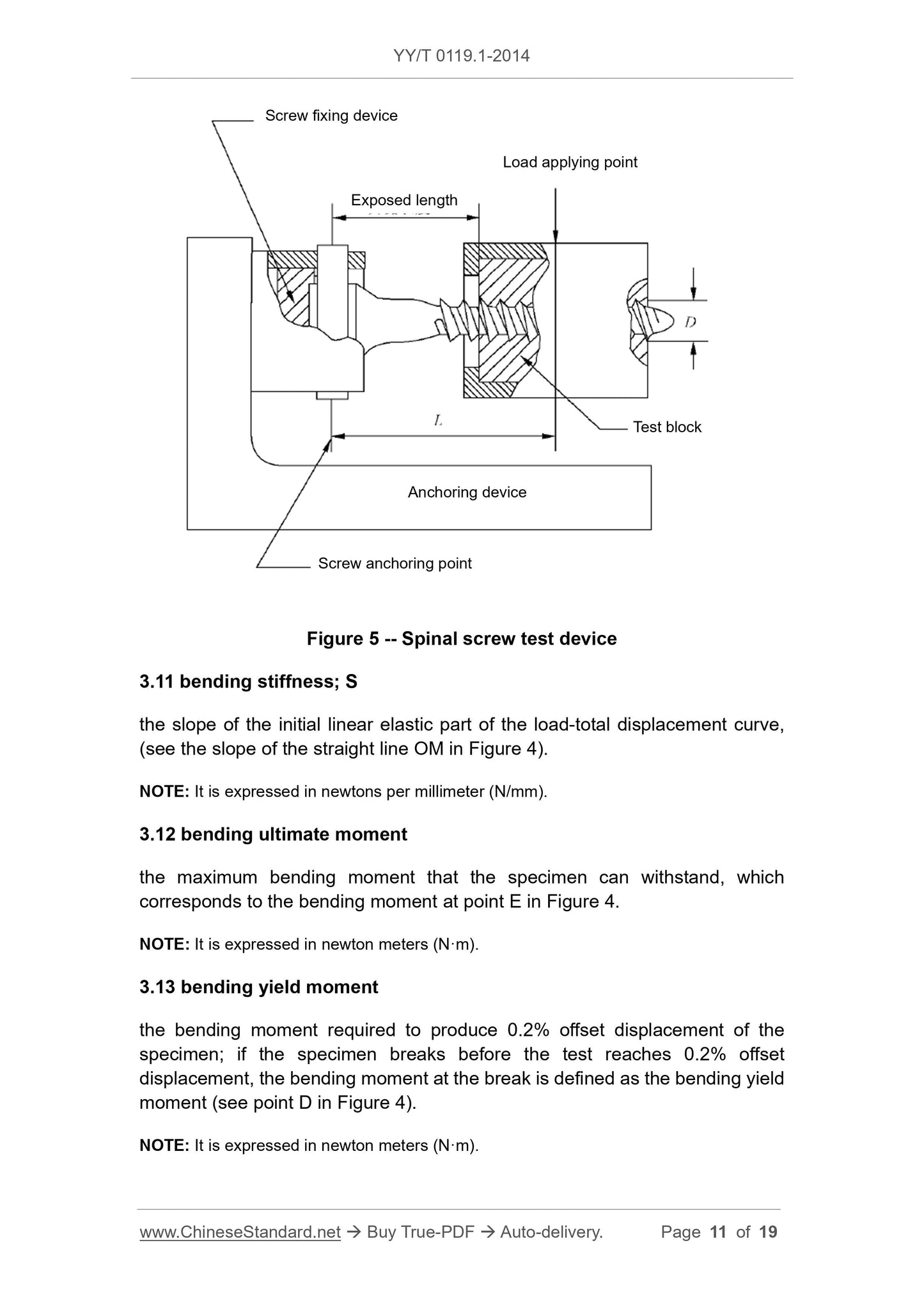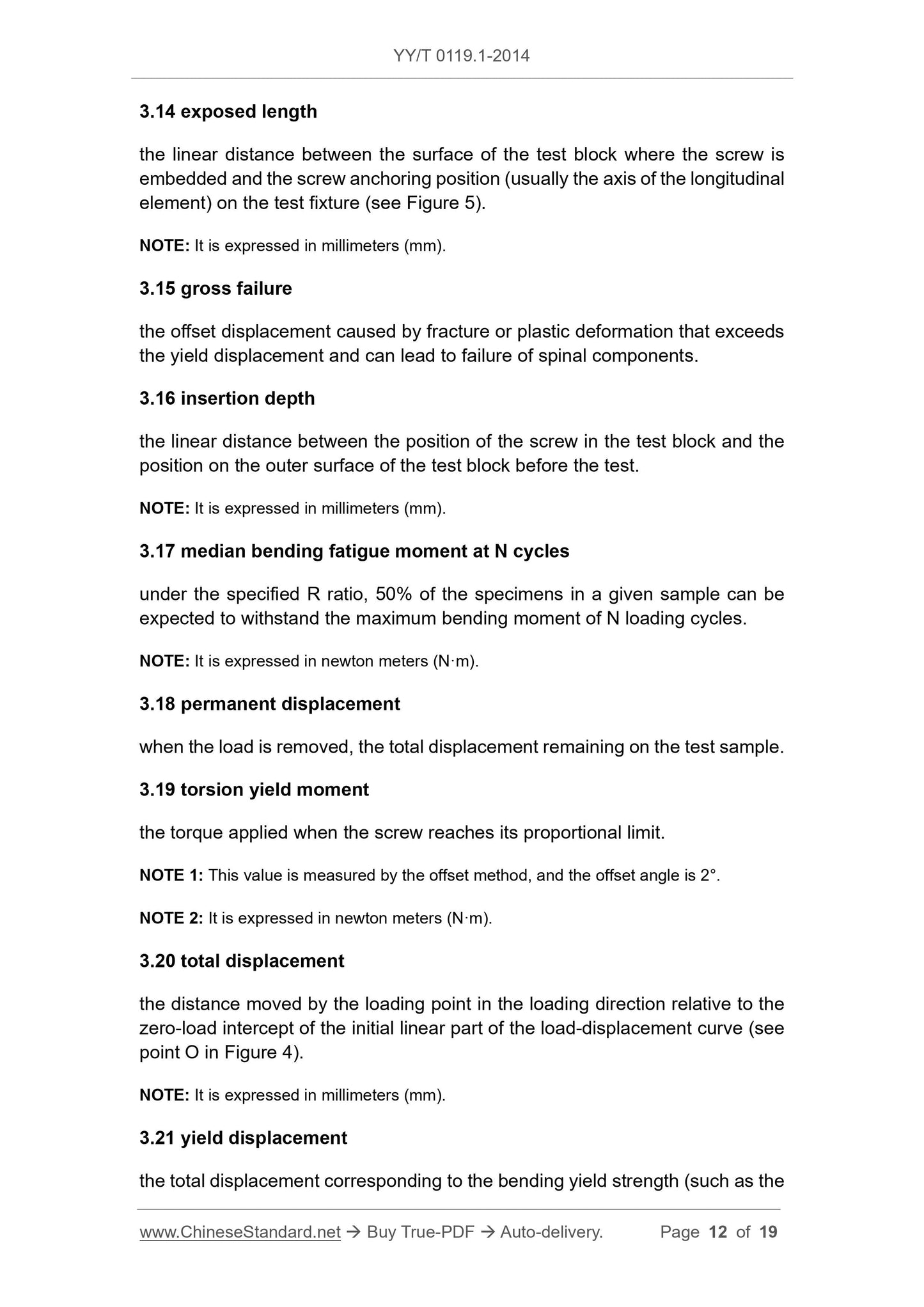1
/
su
12
PayPal, credit cards. Download editable-PDF & invoice in 1 second!
YY/T 0119.1-2014 English PDF (YYT0119.1-2014)
YY/T 0119.1-2014 English PDF (YYT0119.1-2014)
Prezzo di listino
$230.00 USD
Prezzo di listino
Prezzo scontato
$230.00 USD
Prezzo unitario
/
per
Spese di spedizione calcolate al check-out.
Impossibile caricare la disponibilità di ritiro
Delivery: 3 seconds. Download true-PDF + Invoice.
Get QUOTATION in 1-minute: Click YY/T 0119.1-2014
Historical versions: YY/T 0119.1-2014
Preview True-PDF (Reload/Scroll if blank)
YY/T 0119.1-2014: Spinal implants. Components used in the surgical fixation of the spinal skeletal system. Part 1: General requirements
YY/T 0119.1-2014
GB
PHARMACEUTICAL INDUSTRY STANDARD
OF THE PEOPLE’S REPUBLIC OF CHINA
ICS 11.040.40
C 35
Partly replacing YY 0119-2002, YY 0120-2002
Spinal implants - Components used in the surgical
fixation of the spinal skeletal system - Part 1: General
requirements
ISSUED ON: JUNE 17, 2014
IMPLEMENTED ON: JULY 01, 2015
Issued by: China Food and Drug Administration
Table of Contents
Foreword ... 3
Introduction ... 5
1 Scope ... 6
2 Normative references ... 6
3 Terms and definitions ... 7
4 Meaning and application ... 13
5 Materials ... 13
6 Requirements ... 14
7 Manufacture ... 14
8 Sterilization ... 14
9 Packaging ... 14
10 Information provided by the manufacturer ... 14
Annex A (informative) Basic principle ... 16
Annex B (informative) List of approved method standards for chemical analysis
... 18
Bibliography ... 19
Spinal implants - Components used in the surgical
fixation of the spinal skeletal system - Part 1: General
requirements
1 Scope
This Part of YY/T 0119 specifies the general terms used to describe the
dimensions and other physical characteristics of the components used in the
surgical fixation of the spinal skeletal system. It also specifies the requirements
for materials, manufacturing, sterilization, packaging, and information provided
by the manufacturer for the components used in the surgical fixation of the
spinal skeletal system.
2 Normative references
The following referenced documents are indispensable for the application of
this document. For dated references, only the edition cited applies. For undated
references, the latest edition of the referenced document (including any
amendments) applies.
GB 4234, Stainless steel for surgical implants
GB/T 10623, Metallic material - Mechanical testing - Vocabulary
GB/T 13810, Wrought titanium and titanium alloy for surgical implants
GB/T 16825.1, Verification of static uniaxial testing machines - Part 1:
Tension/compression testing machines - Verification and calibration of the
force-measuring system
GB 23102, Implants for surgery - Metallic materials - Wrought titanium -
6aluminium-7niobium alloy
YY/T 0119.2-2014, Spinal implants - Components used in the surgical
fixation of the spinal skeletal system - Part 2: Metallic spinal screws
YY/T 0119.3-2014, Spinal implants - Components used in the surgical
fixation of the spinal skeletal system - Part 3: Metallic spinal plates
YY/T 0119.4-2014, Spinal implants - Components used in the surgical
fixation of the spinal skeletal system - Part 4: Metallic spinal rods
YY/T 0640-2008, Non-active surgical implants - General requirements
YY/T 0857, Standard test methods for spinal implant constructs in a
vertebrectomy model
YY/T 0961, Standard guide for evaluating the static and fatigue properties of
interconnection mechanisms and subassemblies used in spinal arthrodesis
implants
ISO 5832-2, Implants for surgery – Metallic materials -Part 2: Unalloyed
titanium)
ISO 5832-3, Implants for surgery - Metallic materials - Part 3: Wrought
titanium6-aluminium4-vanadiumalloy
ASTM F 382, Specification and Test Method for Metallic Bone Plates
ASTM F 543, Specification and Test Methods for Metallic Medical Bone
Screws
ASTM F 1582, Terminology Relating to Spinal Implants
3 Terms and definitions
For the purposes of this document, the terms and definitions defined in GB/T
10623, YY/T 0857, YY/T 0961, ASTM F 382, ASTM F 543, ASTM F 1582 as
well as the followings apply.
3.1 expansion head screw
a threaded anchor that the head can be elastically deformed, and it is
mechanically connected to other spine structural elements.
3.2 locking screw
a threaded anchor that is rigidly connected to longitudinal elements in spinal
structure.
3.3 self-locking screw
a threaded anchor that deforms at the end of the screwing process and locks
with the mating spine structural element.
3.4 shaft screw
a threaded anchor of which the thread diameter is equal to the diameter of its
non-threaded rod.
3.14 exposed length
the linear distance between the surface of the test block where the screw is
embedded and the screw anchoring position (usually the axis of the longitudinal
element) on the test fixture (see Figure 5).
NOTE: It is expressed in millimeters (mm).
3.15 gross failure
the offset displacement caused by fracture or plastic deformation that exceeds
the yield displacement and can lead to failure of spinal components.
3.16 insertion depth
the linear distance between the position of the screw in the test block and the
position on the outer surface of the test block before the test.
NOTE: It is expressed in millimeters (mm).
3.17 median bending fatigue moment at N cycles
under the specified R ratio, 50% of the specimens in a given sample can be
expected to withstand the maximum bending moment of N loading cycles.
NOTE: It is expressed in newton meters (N·m).
3.18 permanent displacement
when the load is removed, the total displacement remaining on the test sample.
3.19 torsion yield moment
the torque applied when the screw reaches its proportional limit.
NOTE 1: This value is measured by the offset method, and the offset angle is 2°.
NOTE 2: It is expressed in newton meters (N·m).
3.20 total displacement
the distance moved by the loading point in the loading direction relative to the
zero-load intercept of the initial linear part of the load-displacement curve (see
point O in Figure 4).
NOTE: It is expressed in millimeters (mm).
3.21 yield displacement
the total displacement corresponding to the bending yield strength (such as the
distance OA in Figure 4).
NOTE: It is expressed in millimeters (mm).
4 Meaning and application
4.1 The spinal implant system usually consists of several components. Screws,
plates, and rods are part of many spinal implant structures. These components
are designed to transfer loads between the bones and the longitudinal and/or
transverse elements. This Part makes provisions for these components and
defines standard equivalent test methods for evaluating different types of
components.
4.2 The loading method of the spinal component in the body may be different
from the loading method of the loading device explained in this Part, therefore,
the results obtained when using this Part of the test may not be able to predict
the in vivo performance of the component or structure as a whole. However,
these tests can be used to compare the mechanical properties of different types
of components.
4.3 The mechanical characteristics related to the performance of the spinal
components measured in this Part can be used to predict the mechanical
properties of components with similar functions and indications but with
different types.
5 Materials
5.1 The manufacturer is responsible for ensuring that the materials used to
manufacture the spinal components are suitable for implantation in the human
body. The applicability of the material can be verified in accordance with the
method of YY/T 0640.
5.2 When choosing a material, the manufacturer shall also consider the
materials of other components in the spinal implant structure. When mixing
different materials in the structure of spinal implants, unacceptable corrosion
shall be prevented.
5.3 Some materials that have been used as spinal components are given below:
- Pure titanium (ISO 5832-2); ...
Get QUOTATION in 1-minute: Click YY/T 0119.1-2014
Historical versions: YY/T 0119.1-2014
Preview True-PDF (Reload/Scroll if blank)
YY/T 0119.1-2014: Spinal implants. Components used in the surgical fixation of the spinal skeletal system. Part 1: General requirements
YY/T 0119.1-2014
GB
PHARMACEUTICAL INDUSTRY STANDARD
OF THE PEOPLE’S REPUBLIC OF CHINA
ICS 11.040.40
C 35
Partly replacing YY 0119-2002, YY 0120-2002
Spinal implants - Components used in the surgical
fixation of the spinal skeletal system - Part 1: General
requirements
ISSUED ON: JUNE 17, 2014
IMPLEMENTED ON: JULY 01, 2015
Issued by: China Food and Drug Administration
Table of Contents
Foreword ... 3
Introduction ... 5
1 Scope ... 6
2 Normative references ... 6
3 Terms and definitions ... 7
4 Meaning and application ... 13
5 Materials ... 13
6 Requirements ... 14
7 Manufacture ... 14
8 Sterilization ... 14
9 Packaging ... 14
10 Information provided by the manufacturer ... 14
Annex A (informative) Basic principle ... 16
Annex B (informative) List of approved method standards for chemical analysis
... 18
Bibliography ... 19
Spinal implants - Components used in the surgical
fixation of the spinal skeletal system - Part 1: General
requirements
1 Scope
This Part of YY/T 0119 specifies the general terms used to describe the
dimensions and other physical characteristics of the components used in the
surgical fixation of the spinal skeletal system. It also specifies the requirements
for materials, manufacturing, sterilization, packaging, and information provided
by the manufacturer for the components used in the surgical fixation of the
spinal skeletal system.
2 Normative references
The following referenced documents are indispensable for the application of
this document. For dated references, only the edition cited applies. For undated
references, the latest edition of the referenced document (including any
amendments) applies.
GB 4234, Stainless steel for surgical implants
GB/T 10623, Metallic material - Mechanical testing - Vocabulary
GB/T 13810, Wrought titanium and titanium alloy for surgical implants
GB/T 16825.1, Verification of static uniaxial testing machines - Part 1:
Tension/compression testing machines - Verification and calibration of the
force-measuring system
GB 23102, Implants for surgery - Metallic materials - Wrought titanium -
6aluminium-7niobium alloy
YY/T 0119.2-2014, Spinal implants - Components used in the surgical
fixation of the spinal skeletal system - Part 2: Metallic spinal screws
YY/T 0119.3-2014, Spinal implants - Components used in the surgical
fixation of the spinal skeletal system - Part 3: Metallic spinal plates
YY/T 0119.4-2014, Spinal implants - Components used in the surgical
fixation of the spinal skeletal system - Part 4: Metallic spinal rods
YY/T 0640-2008, Non-active surgical implants - General requirements
YY/T 0857, Standard test methods for spinal implant constructs in a
vertebrectomy model
YY/T 0961, Standard guide for evaluating the static and fatigue properties of
interconnection mechanisms and subassemblies used in spinal arthrodesis
implants
ISO 5832-2, Implants for surgery – Metallic materials -Part 2: Unalloyed
titanium)
ISO 5832-3, Implants for surgery - Metallic materials - Part 3: Wrought
titanium6-aluminium4-vanadiumalloy
ASTM F 382, Specification and Test Method for Metallic Bone Plates
ASTM F 543, Specification and Test Methods for Metallic Medical Bone
Screws
ASTM F 1582, Terminology Relating to Spinal Implants
3 Terms and definitions
For the purposes of this document, the terms and definitions defined in GB/T
10623, YY/T 0857, YY/T 0961, ASTM F 382, ASTM F 543, ASTM F 1582 as
well as the followings apply.
3.1 expansion head screw
a threaded anchor that the head can be elastically deformed, and it is
mechanically connected to other spine structural elements.
3.2 locking screw
a threaded anchor that is rigidly connected to longitudinal elements in spinal
structure.
3.3 self-locking screw
a threaded anchor that deforms at the end of the screwing process and locks
with the mating spine structural element.
3.4 shaft screw
a threaded anchor of which the thread diameter is equal to the diameter of its
non-threaded rod.
3.14 exposed length
the linear distance between the surface of the test block where the screw is
embedded and the screw anchoring position (usually the axis of the longitudinal
element) on the test fixture (see Figure 5).
NOTE: It is expressed in millimeters (mm).
3.15 gross failure
the offset displacement caused by fracture or plastic deformation that exceeds
the yield displacement and can lead to failure of spinal components.
3.16 insertion depth
the linear distance between the position of the screw in the test block and the
position on the outer surface of the test block before the test.
NOTE: It is expressed in millimeters (mm).
3.17 median bending fatigue moment at N cycles
under the specified R ratio, 50% of the specimens in a given sample can be
expected to withstand the maximum bending moment of N loading cycles.
NOTE: It is expressed in newton meters (N·m).
3.18 permanent displacement
when the load is removed, the total displacement remaining on the test sample.
3.19 torsion yield moment
the torque applied when the screw reaches its proportional limit.
NOTE 1: This value is measured by the offset method, and the offset angle is 2°.
NOTE 2: It is expressed in newton meters (N·m).
3.20 total displacement
the distance moved by the loading point in the loading direction relative to the
zero-load intercept of the initial linear part of the load-displacement curve (see
point O in Figure 4).
NOTE: It is expressed in millimeters (mm).
3.21 yield displacement
the total displacement corresponding to the bending yield strength (such as the
distance OA in Figure 4).
NOTE: It is expressed in millimeters (mm).
4 Meaning and application
4.1 The spinal implant system usually consists of several components. Screws,
plates, and rods are part of many spinal implant structures. These components
are designed to transfer loads between the bones and the longitudinal and/or
transverse elements. This Part makes provisions for these components and
defines standard equivalent test methods for evaluating different types of
components.
4.2 The loading method of the spinal component in the body may be different
from the loading method of the loading device explained in this Part, therefore,
the results obtained when using this Part of the test may not be able to predict
the in vivo performance of the component or structure as a whole. However,
these tests can be used to compare the mechanical properties of different types
of components.
4.3 The mechanical characteristics related to the performance of the spinal
components measured in this Part can be used to predict the mechanical
properties of components with similar functions and indications but with
different types.
5 Materials
5.1 The manufacturer is responsible for ensuring that the materials used to
manufacture the spinal components are suitable for implantation in the human
body. The applicability of the material can be verified in accordance with the
method of YY/T 0640.
5.2 When choosing a material, the manufacturer shall also consider the
materials of other components in the spinal implant structure. When mixing
different materials in the structure of spinal implants, unacceptable corrosion
shall be prevented.
5.3 Some materials that have been used as spinal components are given below:
- Pure titanium (ISO 5832-2); ...
Share
